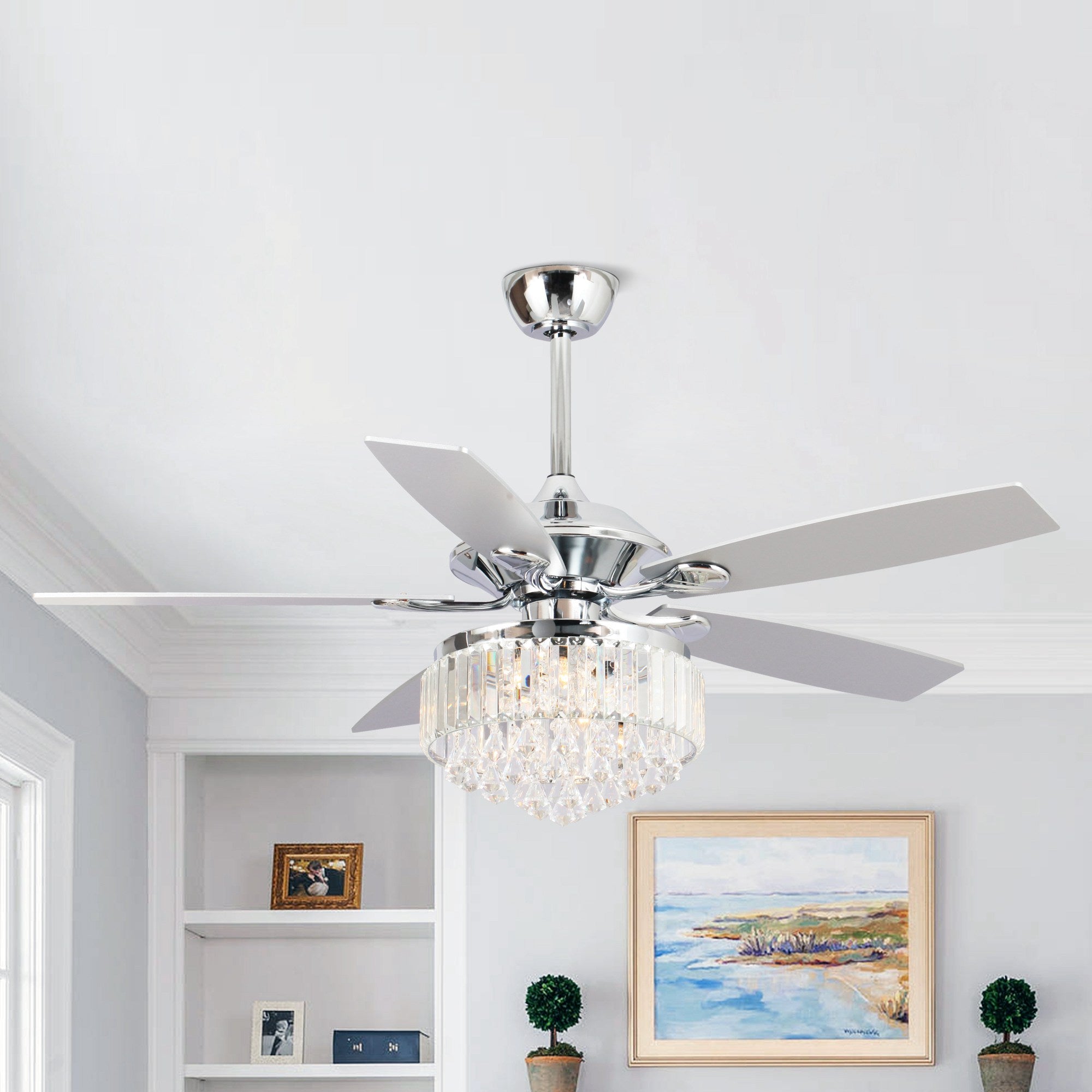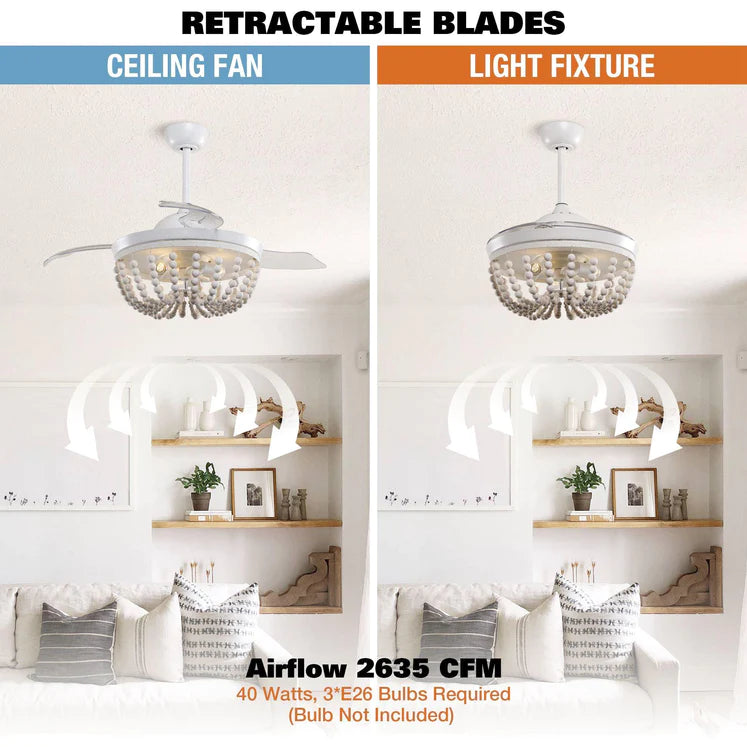How to choose the right ceiling fans

Ceiling fans aren’t just for cooling the room. Our new features and technologies mean they’re more energy-efficient than ever. They are designed to improve airflow, they also help circulate heat throughout your home in the winter. A ceiling fan equipped with a light kit can also be a great way to add an additional source of light. Nowadays, the well-designed ceiling fan also adds a decorative function that ties the room together as the focal point.
Today, we are going to break down everything you need to know—plus share some useful tips on making the right choice for your needs and budget.
Ceiling Fan Size Guide
Size is important. If your ceiling fan is too small for your room, it won’t move air efficiently or effectively. If it’s too big, it could create the feeling of being in a wind tunnel. Here, you can find the right one for your room.
Ceiling fan size is characterized by its diameter. To find the diameter, measure from the end of one blade to the end of the opposite blade. Our ceiling fans come with a different number of blades and blade lengths.
Large
A room that is up to 18' x 20' should feature a fan that is 55" – 60" in diameter. This includes family rooms and large bedrooms.
Larger
Great rooms are more than 18' x 20' and should include a fan that is larger than 60" in diameter. Great rooms are characterized by open floorplans and large foyers.
Common ceiling fan sizes on the market are:
1. 36 inches (90 cm) ceiling fan: suitable for use in small rooms or living rooms.



2. 42 inches (105 cm) ceiling fan: suitable for use in medium-sized rooms or bedrooms.



3. 48 inches (120 cm) ceiling fan: suitable for use in large rooms or living rooms.



4. 52 inches (130 cm) ceiling fan: suitable for use in larger rooms or outdoors.



5. 60 inches (150 cm) ceiling fan: suitable for use in larger rooms or outdoors.



The more popular ceiling fan sizes are 42 inches (105 cm) and 48 inches (120 cm), which can be used at home, as well as in offices, shopping malls and other places, and can meet the needs of most people. Meanwhile, 52-inch (130cm) and 60-inch (150cm) ceiling fans are also popular large fans for larger spaces and outdoor use.
Several common problems in choosing a fan of suitable size

Find Different Style
Now that you've determined the correct ceiling fan size for your room, you need to consider that your ceiling fan should also fit in with and add to the aesthetics of your space. Fans come in dozens of styles: rustic, traditional, industrial, modern and more. Consider your room's current structure and style, and look for a fan that suits it. You can play around with style, finish, blade type, light fixture, and features to customize the perfect ceiling fan. Parrot Uncle designs a variety of ceiling fans. We have multiple finish options, for both the ceiling fan body and blades to coordinate with the style of your home.

Modern
With their sleek designs, clean lines, and warm, neutral colors, modern ceiling fans are simple and understated in appearance. Modern fans vary in form from Scandinavian to mid-century designs.

Traditional
These refined fans typically feature intricate details and thoughtful designs that add richness and warmth to a space. Our traditional ceiling fans blend classic style and innovative features.

Rustic and Farmhouse
An ideal addition to countryside-inspired designs, rustic ceiling fans create a natural feel. Cast-iron inspired housings and weathered blades bring cabin-like charm into the home and outdoor living spaces.

Industrial
Industrial style ceiling fans bring urban-inspired spaces to life drawing inspiration from modern machinery and unique features like propeller-style blades or smooth wood finishes.
Accommodates Various Ceiling Heights
A mounting system should be chosen based on the room's height and ceiling slope. There should be at least seven feet of distance between the floor and the fan blades. Ceiling fans need to be installed at the right height to ensure optimal airflow. If you have a low ceiling, a flush mount or hugger fan is a good option. For high ceilings, you can choose a downrod mount fan that can be adjusted to the right height. If you have a vaulted ceiling or your ceiling is more than nine feet high, we recommend adding a longer downrod. The following are three mount types available for ceiling fans.
Flush Mount
For ceilings less than 8 feet tall, choose a flush-mount ceiling fan. These fans mount next to the ceiling and help maintain the recommended minimum 7-foot clearance between ceiling and floor.
Downrod Mount
When outfitting a fan in a room with high ceilings, the height of the fan can be lowered using a narrow section of pole called the downrod. Downrods usually come in sections as short as 6” long and they secure to the fan casing on one end and the ceiling bracket on the other. They are strong enough to support the weight of the fan against the force of the fan’s motor and the blade’s circular momentum.
Angled Mount
If you have vaulted ceilings with a slope up to 52 degrees, use a hanger ball adapter like our convenient ceiling fan adapter to make sure that your fan hangs straight. Most ceiling fans can hang from sloped or vaulted ceilings that are less than 21 degrees, attachment kits can be bought for fans hanging on slopes that are steeper.
DownRod Length Options
When choosing a ceiling fan rod, it is important to consider the ceiling height to ensure that the fan is mounted at the correct height for optimal performance and safety.
In general, the fan blades should be at least 7 feet above the floor. For ceilings 8 feet or less: A flush-mount or low-profile ceiling fan is recommended for ceilings that are 8 feet or less in height. These fans do not require a downrod and are mounted directly to the ceiling.
Here are some guidelines for selecting the right ceiling fan rod based on ceiling height:

Lights or no lights
Whether the fan is lighted depends on the lighting effect of your room and personal preference. With and without lights have their own characteristics. Next, we will introduce to you the difference between with lights and without lights.

Fans with lights
For spaces with limited natural lighting, purchasing a ceiling fan with lights is a great option to consider. Ceiling fans with light kits can be supplemented with other fixtures to provide sufficient illumination in darker spaces. When looking for ceiling fans with lights, check for integrated light dimming features. Ceiling fans with dimmable lights allow you to set the mood in your space. Our wall controls and handheld remotes make the process of adjusting your lighting easy, too.

Fans without lights
If you plan to install your new fan in a room with good natural lighting or ample light from other sources, a ceiling fan without lights is a good option. If you decide that you need more lighting in the future, many ceiling fan models can be easily modified after installation with the appropriate light kit.
Fandelier
Fandelier ceiling fans are generally more industrial in style, and with unique lamps, they look like a ceiling light. This style is more resource-efficient and has light and wind at the same time. The fandelier designed by Parrot Uncle can have a variety of choices, and you can choose the fan that suits you according to the decoration style of your home.
Retracable
A retractable ceiling fan is a type of fan that features retractable blades. These blades retract when turned off and spread out when it is turned on. Retractable ceiling fans are both functional and stylish. They are a must-have for a lot of houses because they help keep the energy bill low by circulating air throughout the rooms. They come in a wide array of styles, sizes, and designs that you can easily find the one that suits the theme of your home. They usually have a chandelier look that gives off an industrial feel. They are ideal for modern and even traditional-style houses. You can choose from a wide array of styles that are available on our website.
Smart Fan
Smart Ceiling Fan equipped with modern technology. Mayna Smart Ceiling Fan connects with the ParrotUncle Smart app, Google Home and Alexa. So you can control fan speed and light brightness by voice and app. The dimmable led lights are more energy-saving, provides a soft, non-glaring LED light source, and are eye-friendly. The Wi-Fi component and remote receiver are built into this modern ceiling fan so you can have it up and running in no time.
Number of Blades
Ceiling fans have different numbers of blades and different ranges of air supply. Generally speaking, the more blades, the wider the air supply range. The number of blades can vary depending on the size of the room or personal preference. Parrot Uncle offers you a variety of options:2-Blade, 3-Blade, 4-Blade, 5-Blade, 6-Blade, 7-Blade, 8-Blade.
The material of the fan blade is one of the important factors that determine the performance and life of the fan. Choosing a fan blade material requires consideration of several factors and should be evaluated based on the environment in which the fan will be used and personal preference. The following are common fan blade materials:
ABS
ABS fan blades are stronger and more durable than other plastic materials, not easily deformed or worn. ABS material has good UV resistance and is not easy to fade or turn yellow. Compared with plastic fan blades, ABS fan blades produce less noise and vibration, and are relatively smooth when rotating at high speeds. Fans with ABS blades are suitable for occasions that require relatively high durability and stability.
Plastic
Plastic blades are lighter than blades made of other materials, making the fan more portable and easy to move. Easier to clean than other material fan blades, just wipe with a damp cloth. Plastic fan blades are generally more durable than wood fan blades and won't warp or break as easily. Fans with plastic blades are suitable for occasions that require light weight such as homes or offices.
PC
PC fan blade is a fan blade material made of polycarbonate. It has high thermal stability and can withstand high temperature and high humidity environments. PC fan blades are stronger and more durable than other plastic materials, not easily deformed or worn.
Plywood
Plywood fan blade is a fan blade material made of multi-layer thin wood boards. With natural wood grain and texture, it can add a nice look to the fan. Sturdy and durable, not easy to deform or wear. Plywood material is made of natural wood, which is more environmentally friendly than plastic fan blades. Fans with Plywood blades are suitable for occasions that require aesthetics and environmental protection, such as family living rooms and restaurants.
Control Options
Our fan remotes offer push-button controls for the different speed settings, as well as the light settings. The remote controls can be held in hand and used throughout the room, or it can be left on the wall and easy to find.
The classic pull chain is still a staple for controlling any available light and the speed of a ceiling fan, for an even more convenient experience, many ceiling fans with remotes are available.
The wall control is a device that allows you to control the speed and direction of your Parrot Uncle ceiling fan from a wall-mounted switch. This type of control eliminates the need for a pull chain and provides a more convenient way to operate your ceiling fan.
Smart remote control, you can control the ceiling fan through the sound, through the APP, through the remote control. A perfect integration with modern technology has been realized.
Motor Quality
Better Motor, Less noise&energy cost
We know ceiling fan is a hardworking household appliance, and choosing one that will last starts with what’s inside. This is especially important for ceiling fans that will be used often and for hours at a time, such as in bedrooms or living rooms. Parrot Uncle designs ceiling fans that are well-balanced and will not wobble or make noise, even after decades of use. In addition, a motor with a reverse function enables your ceiling fan to be used year-round.

AC (alternating current) and DC (direct current) motors are two different types of electric motors that convert electrical energy into mechanical energy. Here are some of the main differences between AC motors and DC motors:
Overall, both AC and DC motors have their own unique advantages and disadvantages, and the choice between them depends on the specific application and requirements.
Energy Efficiency
Ceiling fans are a popular and cost-effective way to cool a room or space. When it comes to energy efficiency, ceiling fans are generally much more efficient than other cooling options like air conditioners. Here are some factors that affect the energy efficiency of ceiling fans:
Energy efficiency: 59.72
Size: The size of the fan blades and the size of the room will affect the energy efficiency of the ceiling fan. A larger fan blade will generally move more air, which can help cool a larger room more efficiently.
Speed: Running a ceiling fan on a higher speed will use more energy, but it can also provide more cooling power. Running the fan at a lower speed will use less energy, but may not provide as much cooling.
Energy efficiency: 163.73
Direction: Most ceiling fans have a switch that allows you to change the direction of the blades. Running the fan in a counterclockwise direction during the summer will create a cooling breeze, while running it in a clockwise direction during the winter can help circulate warm air.
Energy Star certification: Look for ceiling fans that are Energy Star certified. These fans are tested and certified to meet certain energy efficiency standards, which can help save energy and reduce electricity bills.
Overall, ceiling fans can be a very energy-efficient way to cool a room or space, as long as they are used correctly and maintained properly. Regular cleaning and maintenance, such as dusting the blades and ensuring the fan is balanced, can also help ensure optimal performance and energy efficiency.
CFM
Ceiling fans are the most economical way to cool down on hot summer days. Replacing some of your air conditioner with ceiling fans can significantly lower your monthly energy bills. There are also many factors to consider when purchasing a ceiling fan. When shopping online, you may notice that one factor commonly listed in product descriptions is CFM.

What Is CFM?
CFM stands for Cubic Feet per Minute. It is a measure of the volume of air that a fan or blower can move in one minute. It is commonly used to rate the airflow capacity of ventilation systems, air compressors, and cooling systems. The higher the CFM rating, the more air the device can move in a given amount of time.
Importance of CFM
1. Comfort: Ceiling fan CFM is an important factor in maintaining a comfortable indoor environment by ensuring proper air circulation. Higher CFM can result in better air movement, which can help to cool down the room, making it more comfortable for the occupants.
2. Energy efficiency: Ceiling fan CFM is also important for energy efficiency. A ceiling fan with a higher CFM can circulate air more efficiently, reducing the need for air conditioning or heating. This can result in lower energy consumption and costs.
3. Room size: Ceiling fan CFM is also important in determining the appropriate fan size for a room. A ceiling fan with a low CFM may not be sufficient to effectively circulate air in a large room, while a fan with a high CFM in a small room can cause discomfort and excessive air movement.
4. Noise level: Ceiling fan CFM can also impact the noise level of the fan. A high CFM ceiling fan may generate more noise due to the increased air movement, while a low CFM fan may be quieter but less effective in circulating air.
Factors Affecting CFM
Several factors can affect the CFM (Cubic Feet per Minute) of a ceiling fan, including:
1. Blade pitch: The angle of the blades, also known as the blade pitch, can affect the CFM of a ceiling fan. A steeper blade pitch can move more air, resulting in a higher CFM.
2. Blade length: The length of the blades can also impact the CFM of a ceiling fan. Longer blades can move more air, resulting in a higher CFM.
3. Motor size: The size and power of the motor can affect the CFM of a ceiling fan. A larger and more powerful motor can move more air, resulting in a higher CFM.
4. Blade shape: The shape of the blades can also affect the CFM of a ceiling fan. Blades with a curved shape can move more air than flat blades, resulting in a higher CFM.
5. Ceiling height: The height of the ceiling can also affect the CFM of a ceiling fan. A higher ceiling may require a larger and more powerful fan to effectively circulate air, resulting in a higher CFM.
6. Room size: The size of the room can also impact the CFM of a ceiling fan. A larger room may require a larger and more powerful fan to effectively circulate air, resulting in a higher CFM.
How much CFM do I need?
The amount of CFM (Cubic Feet per Minute) you need depends on several factors, including the size of the room, ceiling height.
| Room Size | CFM |
|---|---|
| Small (up to 75 sq ft) | 2000 - 3000 |
| Medium (up to 175 sq ft) | 3000 - 4000 |
| Large (up to 350 sq ft) | 4000 - 6000 |
| Great (more than 350 sq ft) | 5000 - 9000 |
For very large spaces, it may be worth considering multiple fans.
| Ceiling Height | CFM |
|---|---|
| 8 feet | 1500 - 3000 |
| 9 feet | 2000 - 3500 |
| 10 feet | 2500 - 4000 |
| 12 feet | 4000 - 5500 |
In summary, CFM is an essential measurement for designing, operating, and maintaining ventilation systems, and it plays a crucial role in ensuring energy efficiency, comfort, health, safety, equipment performance, and compliance.
Other Tips

Installation
When you are ready to address ceiling fan installation, it’s important to consult a licensed electrician who will know how to install a ceiling fan safely and accurately. Because ceiling fans are heavier than the average light fixture, special considerations should be made concerning ceiling fan wiring to ensure the location is strong enough to support the fan and the wiring doesn’t pose a hazard. Ceiling fan assembly is usually minimal and requires only attaching the blades to the motor but hanging the fan can be more complicated; safety is crucial. Your new fan will come boxed with all the necessary parts and instructions so your electrician can install your new fixture with ease.
Parrot Uncle remote control
connection guide
Budget
Ceiling fan design gives your home personality, provides ambience, and serves a functional purpose. However, many people don’t think about fan when remodeling their home, so they don’t budget for it. We recommend you to budget the ceiling fan at the beginning of your project.
Parrot Uncle designs ceiling fans for every space and budget. Shop our fans by price to find a fit that's perfect for your needs and budget. If you are on a budget, doesn’t mean you can’t add style, increase the perceived value of your home, and get practical use from ceiling fan. There are some budget-friendly brands like Parrot Uncle which have so many choices and would help you to incorporate visual appeal with functionality.
Having ceiling fans can add style and also provide comfort to your home. Not only does it look great, but it can also help circulate the air and lower your energy bills.
Finally, buying a ceiling fan that is not only functional but also adds a little puzzas in the space from a reliable vendor is also important. Parrot Uncle offers free shipping in the U.S.A., fast return, five-star warranty and a technical support team ready to answer all your questions. Thank you for reading!

























